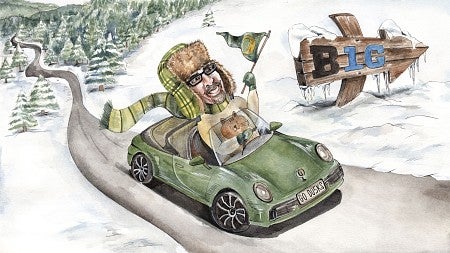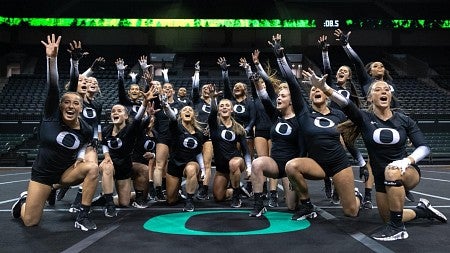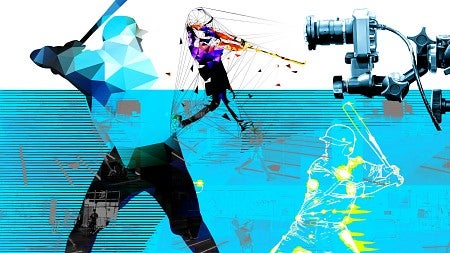
Running Down Questions about Marathons and Fatigue
Podcast: sports scientist Mike Hahn pursues research that serves elite athletes and the rest of u
By Matt Cooper • Podcast produced by Chris Larsen • Illustration by David Gill • April 3, 2024
3 min read
When Mike Hahn got the word out that he needed subjects for a study on marathons and fatigue, Eugene runners came running.
Hahn, a human physiology professor in the College of Arts and Sciences and director of the Bowerman Sports Science Center, is an expert in sports science. Working with athletes wearing sensors, he studies lower limb musculoskeletal biomechanics, injury prevention, and improved performance in sport.
Hahn’s team recently turned their attention to distance running and how the legs’ absorption of the impact of foot strike changes as the miles pile up. Their research, which could yield insights on injury prevention, hinged on the willingness of runners to run at a variety of paces, uphill and downhill on a treadmill in the lab and around Eugene while being hooked up to all manner of monitoring equipment.
Fortunately, in TrackTown, USA, there’s no shortage of runners willing to go the distance for science. In early 2022, Hahn’s team put out the call for subjects at local trails and running stores and soon had scores of participants of all ages and abilities, some of them weekend 5kers and others fast enough to qualify for the Boston Marathon.
“The community generally loves being involved in research,” Hahn says. “And if it’s something that they’re passionate about like running, it’s pretty easy to recruit.”
Pro tip: be hard core
Hahn’s research has given him insights into how to get the most out of your run (listen for tips and more in the accompanying podcast). Among them: strengthen your core—that’s the pelvis, lower back, hips, and stomach—to stabilize your torso for long runs.
“Once you get into a spot where the pelvis control is strong,” Hahn says, “you can run with less fatigue, for longer.”
Giving ACL tears the boot
Hahn’s team is also studying the role that soccer cleats could play in reducing ACL tears and other injuries for female athletes. Working with Hahn, PhD student Emily Karolidis, MS ’22 (individualized program), is examining soccer cleats’ stud length, shape, and more for her dissertation research.
“We need more scientists addressing female athlete research questions specifically,” Hahn says. “Emily represents the next generation of human performance researchers, directly shaping the future of footwear biomechanics and product design.”
Hear more from Hahn: Science Knight Out
The soccer cleat research is supported by the Wu Tsai Human Performance Alliance at Oregon, a global effort of six institutions to promote wellness and peak performance through science.
“Once you get into a spot where the pelvis control is strong, you can run with less fatigue, for longer.”
—Mike Hahn
“Wearable sensors are enabling us to crack the code on athletic performance,” Hahn says. “When combined with machine learning, sensors are improving performance and resilience for athletes around the world.
“This blend of technology development and problem solving makes me excited to go to work every day.”
Matt Cooper is managing editor for Oregon Quarterly.
Chris Larsen, MS ’18 (journalism), is a videographer and photographer with University Communications.




